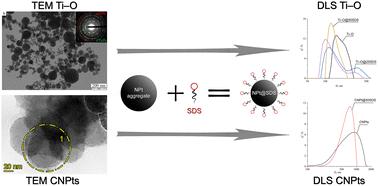当前位置:
X-MOL 学术
›
New J. Chem.
›
论文详情
Our official English website, www.x-mol.net, welcomes your feedback! (Note: you will need to create a separate account there.)
Plasma synthesis of Ti–O and carbon nanoparticles and their modification with an anionic surfactant to obtain stable dispersions
New Journal of Chemistry ( IF 2.7 ) Pub Date : 2024-07-23 , DOI: 10.1039/d4nj01622j Dmitry Olegovich Zelentsov 1 , Yuliya Yurievna Petrova 1 , Valentina Viktorovna Egorova 1 , Pavel Vadimovich Povalyaev 1, 2 , Evgeniya Vladimirovna Frantsina 1, 2 , Anastasia Alexandrovna Ivanova 1, 3 , Alexey Nikolayevich Cheremisin 1, 3 , Alexander Anatolyevich Sivkov 4 , Ivan Igorevich Shanenkov 4, 5 , Artur Nassyrbayev 4 , Dmitriy Sergeevich Nikitin 4
New Journal of Chemistry ( IF 2.7 ) Pub Date : 2024-07-23 , DOI: 10.1039/d4nj01622j Dmitry Olegovich Zelentsov 1 , Yuliya Yurievna Petrova 1 , Valentina Viktorovna Egorova 1 , Pavel Vadimovich Povalyaev 1, 2 , Evgeniya Vladimirovna Frantsina 1, 2 , Anastasia Alexandrovna Ivanova 1, 3 , Alexey Nikolayevich Cheremisin 1, 3 , Alexander Anatolyevich Sivkov 4 , Ivan Igorevich Shanenkov 4, 5 , Artur Nassyrbayev 4 , Dmitriy Sergeevich Nikitin 4
Affiliation

|
Mixtures of nanoparticles and surfactants are attracting researchers’ interest from around the world for the development of chemically enhanced oil recovery. Nanoparticles modified with surfactants are able to adsorb at the oil–water interface reducing the interfacial tension or adsorb at the reservoir rock surface changing its wettability from oil-wet to water-wet. This change leads to an oil recovery increase. Therefore, in this work, we obtained Ti–O Magneli phases and carbon nanoparticles via the plasma dynamic method and in an electric arc, respectively. Subsequently, these nanoparticles were modified with an anionic surfactant and characterized by Fourier-transform infrared spectroscopy, X-ray fluorescence, thermogravimetric analysis, differential scanning calorimetry, and scanning and transmission electron microscopy. The stability and properties of dispersions were studied by tensiometry and dynamic and electrophoretic light scattering methods. It was shown that Ti–O Magneli phases (10–180 nm) and carbon (60–80 nm) nanoparticles modified in sodium dodecyl sulfate solutions formed stable dispersions in water. Furthermore, Ti–O nanoparticles and modified carbon nanoparticles effectively reduced the interfacial tension at the n-hexane/water interface.
中文翻译:

Ti-O和碳纳米粒子的等离子体合成及其用阴离子表面活性剂的改性以获得稳定的分散体
纳米粒子和表面活性剂的混合物吸引了世界各地研究人员对化学强化石油采收率开发的兴趣。用表面活性剂改性的纳米颗粒能够吸附在油水界面,降低界面张力或吸附在储层岩石表面,改变其润湿性,从油湿性变为水湿性。这一变化导致石油采收率增加。因此,在这项工作中,我们分别通过等离子体动力学方法和电弧获得了 Ti-O Magneli 相和碳纳米颗粒。随后,这些纳米粒子用阴离子表面活性剂进行修饰,并通过傅里叶变换红外光谱、X射线荧光、热重分析、差示扫描量热法以及扫描和透射电子显微镜进行表征。通过张力测定法、动态光散射法和电泳光散射法研究了分散体的稳定性和性能。结果表明,在十二烷基硫酸钠溶液中修饰的 Ti-O Magneli 相(10-180 nm)和碳(60-80 nm)纳米粒子在水中形成稳定的分散体。此外,Ti-O纳米颗粒和改性碳纳米颗粒有效降低了正己烷/水界面的界面张力。
更新日期:2024-07-24
中文翻译:

Ti-O和碳纳米粒子的等离子体合成及其用阴离子表面活性剂的改性以获得稳定的分散体
纳米粒子和表面活性剂的混合物吸引了世界各地研究人员对化学强化石油采收率开发的兴趣。用表面活性剂改性的纳米颗粒能够吸附在油水界面,降低界面张力或吸附在储层岩石表面,改变其润湿性,从油湿性变为水湿性。这一变化导致石油采收率增加。因此,在这项工作中,我们分别通过等离子体动力学方法和电弧获得了 Ti-O Magneli 相和碳纳米颗粒。随后,这些纳米粒子用阴离子表面活性剂进行修饰,并通过傅里叶变换红外光谱、X射线荧光、热重分析、差示扫描量热法以及扫描和透射电子显微镜进行表征。通过张力测定法、动态光散射法和电泳光散射法研究了分散体的稳定性和性能。结果表明,在十二烷基硫酸钠溶液中修饰的 Ti-O Magneli 相(10-180 nm)和碳(60-80 nm)纳米粒子在水中形成稳定的分散体。此外,Ti-O纳米颗粒和改性碳纳米颗粒有效降低了正己烷/水界面的界面张力。












































 京公网安备 11010802027423号
京公网安备 11010802027423号